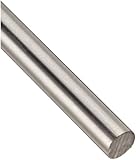All Categories


304 Stainless Steel Round Rod, Unpolished (Mill) Finish, Annealed, AMS 5639/ASTM A276/AMS QQ-S 763/ASTM A276, 2.625" Diameter, 24" Length
Share Tweet
*Price and Stocks may change without prior notice
*Packaging of actual item may differ from photo shown
- Electrical items MAY be 110 volts.
- 7 Day Return Policy
- All products are genuine and original








304 Stainless Steel Round Rod, Unpolished Features
-
304 stainless steel is the most commonly used grade of stainless steel due to its combination of corrosion resistance, weldability, and formability
-
Unpolished (mill) surface has no finish
-
Meets AMS 5639, AMS QQ-S-763, and ASTM A276 specifications
-
Annealed after shaping to modify the metal's properties
-
Standard tolerance
About 304 Stainless Steel Round Rod, Unpolished
The 304 stainless steel round rod has an unpolished (mill) surface, meets SAE Aerospace Material Specifications AMS 5639 and QQ-S-763 and American Society for Testing and Materials International ASTM A276 specifications, and has a standard tolerance. The 304 stainless steel grade is a general-purpose material that combines corrosion resistance, weldability, and formability, making it the most commonly used grade of stainless steel. An austenitic stainless steel that is one of the 18-8 grades, 304 can be cold worked to increase its hardness and strength while maintaining most of its formability. The material is typically nonmagentic but may become slightly magnetic when cold worked. The material has been annealed, a method of heating and cooling metal to modify its properties, such as increasing its formability and toughness or decreasing its strength, after it has been shaped. Stainless steel is an iron alloy with resistance to staining and rusting in many environments where steel would typically degrade. The chemical composition of each grade creates a grain structure that falls into one of five classes: austenitic, duplex, ferritic, martensitic, and precipitation hardening. The austenitic class contains the most formable, weldable, and corrosion-resistant stainless steel grades, but they cannot be heat treated. The duplex class offers high resistance to pitting and chloride stress corrosion cracking. Duplex grades are heat treatable and roughly twice as strong as austenitic grades. The ferritic class contains moderately formable and corrosion-resistant grades compared to other stainless steel classes, but they cannot be heat treated. The martensitic class includes some of the hardest and strongest stainless steel grades that also offer mild corrosion resistance, high hardness, and good formability. Martensitic grades can be heat treated. The precipitation-hardening (PH) class can be heat treated after fabrication to achieve some of the highest hardness ratings in stainless steel. Tensile strength, used to indicate the material’s overall strength, is the peak stress it can withstand before it breaks. Corrosion resistance describes the material's ability to prevent deterioration caused by atmosphere, moisture, or other medium. Wear resistance indicates the ability to prevent surface damage caused by contact with other surfaces. Toughness describes the material's ability to absorb energy before breaking, while hardness (commonly measured as indentation hardness) describes its resistance to permanent surface deformation. Formability indicates how easily the material can be permanently shaped. Machinability describes how easily it can be cut, shaped, finished, or otherwise machined, while weldability characterizes the ability to be welded. Magnetism characterizes how much the material is repelled by or attracted to a magnet.






























